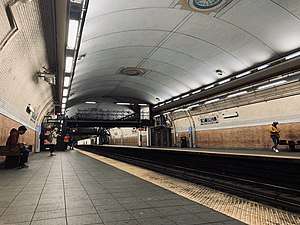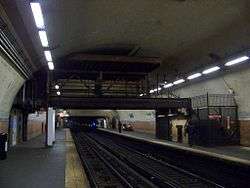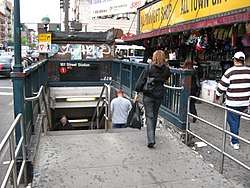181st Street station (IRT Broadway–Seventh Avenue Line)
181st Street is a local station on the IRT Broadway–Seventh Avenue Line of the New York City Subway. Located at the intersection of St. Nicholas Avenue and 181st Street in Washington Heights, Manhattan, it is served by the 1 train at all times.
181 Street | |||||||
|---|---|---|---|---|---|---|---|
 Renovated platform view | |||||||
| Station statistics | |||||||
| Address | West 181st Street & Saint Nicholas Avenue New York, NY 10033 | ||||||
| Borough | Manhattan | ||||||
| Locale | Washington Heights | ||||||
| Coordinates | 40.849°N 73.934°W | ||||||
| Division | A (IRT) | ||||||
| Line | IRT Broadway–Seventh Avenue Line | ||||||
| Services | 1 | ||||||
| Transit connections | |||||||
| Structure | Underground | ||||||
| Depth | 120 feet (37 m) | ||||||
| Platforms | 2 side platforms | ||||||
| Tracks | 2 | ||||||
| Other information | |||||||
| Opened | May 30, 1906 | ||||||
| Station code | 301[1] | ||||||
| Accessible | |||||||
| Wireless service | |||||||
| Opposite-direction transfer available | Yes | ||||||
| Traffic | |||||||
| Passengers (2019) | 3,523,536[3] | ||||||
| Rank | 143 out of 424[3] | ||||||
| Station succession | |||||||
| Next north | 191st Street: 1 | ||||||
| Next south | 168th Street: 1 | ||||||
| |||||||
| |||||||
| |||||||
181st Street Subway Station (IRT) | |||||||
| MPS | New York City Subway System MPS | ||||||
| NRHP reference No. | 05000224[4] | ||||||
| Added to NRHP | March 30, 2005 | ||||||
This station will be closed between March 2021 and February 2022 for elevator repair.
History
The West Side Branch of the first subway was extended northward to a temporary terminus of 221st Street and Broadway on March 12, 1906 with the station at 181st Street not yet open.[5][6] The 181st Street station opened on May 30, 1906, and on this date express trains on the Broadway branch began running through to 221st Street, eliminating the need to transfer at 157th Street to shuttles.[7]
On June 25, 1909, the New York City Board of Estimate approved an appropriation of $160,000 for the installation of four additional elevators at the station.[8]
In 1948, platforms on the IRT Broadway–Seventh Avenue Line from 103rd Street to 238th Street were lengthened to 514 feet (157 m) to allow full ten-car express trains to stop at this station. Previously, the station could only hold six-car local trains. The platform extensions were opened in stages. On April 6, 1948, the platform extension opened for stations from 103rd Street to Dyckman Street, with the exception of 125th Street.[9][10]
On December 28, 1950, the New York City Board of Transportation issued a report concerning the construction of bomb shelters in the subway system. Five deep stations in Washington Heights, including the 181st Street station, were considered to be ideal for being used as bomb-proof shelters. The program was expected to cost $104 million. These shelters were expected to provide limited protection against conventional bombs, while providing protection against shock waves and air blast, as well as from the heat and radiation from an atomic bomb. To become suitable as shelters, the stations would require water-supply facilities, first-aid rooms, and additional bathrooms.[11]
Elevators
The station reopened on November 22, 1999 upon the completion of elevator installation. The entrance at the southeast corner of 181st Street and St. Nicholas Avenue remained closed until early 2000.[12]
In 2004, the number of elevator attendants at the station and four others in Washington Heights was reduced to one per station as a result of budget cuts by the Metropolitan Transportation Authority (MTA). The agency had intended to remove all the attendants, but kept one in each station after many riders protested. The change saved $1.2 million a year.[13] In November 2007, the MTA proposed savings cuts to help reduce the agency's deficit. As part of the plan, all elevator operators at 181st Street, along with those in four other stations in Washington Heights, would have been cut.[14] On December 7, 2007, the MTA announced that it would not remove the remaining elevator operators at these stations. The move was intended to save $1.7 million a year, but was not implemented due to pushback from elected officials and residents from the area.[15] In October 2018, the MTA again proposed removing the elevator operators at the five stations, but this decision was reversed after dissent from the Transport Workers' Union.[16]
The elevator attendants serve as a way to reassure passengers as the elevators are the only entrance to the platforms, and passengers often wait for the elevators with an attendant.[17] The attendants at the five stations are primarily maintenance and cleaning workers who suffered injuries that made it hard for them to continue doing their original jobs.[18] In October 2018, the MTA again proposed removing the elevator operators at the five stations, but this decision was reversed after dissent from the Transport Workers' Union.[19]
This station will be closed between March 2021 and February 2022 for elevator repair. It is unclear whether the elevator operators will keep their jobs after their replacement.[20][21]
Ceiling collapses
During construction

During the station's construction in the mid-1900s, the Fort George Mine Tunnel was being built to take the Interborough Rapid Transit Company's Broadway–Seventh Avenue line through upper Manhattan. Due to the steep terrain, the tunnel had to be mined using explosives. During construction on October 24, 1903, a 300-ton boulder, weakened by such an explosive, gave way, killing 10 miners.[22] Of these, six were killed instantly and four died later of their injuries; in addition, eight miners were injured.[23] The dead miners consisted of eight Italian immigrants, the foreman from Italy, and an electrician from Germany.[24]
2009 collapse
On August 16, 2009, at around 10:30 pm, a 25-foot section of the bricks lining the 35-foot high curved ceiling of the station collapsed onto both uptown and downtown tracks and platforms. Nobody was injured in the incident.[22] This caused suspension of 1 service between 168th Street and Dyckman Street stations in both directions for eight days with free shuttle buses providing replacement.[25][26] End-to-end service on the 1 was restored on August 24, except trains skipped 181st Street.[26] The station reopened to passengers on August 31, 2009.[27][28]
There was also a partial ceiling collapse at the same station in 2007, according to Judith M. Kunoff, Chief Architect for the NYC Transit Authority.[29] According to NY1, the repairs to the station cost $30 million and did not start until the end of 2012.[30]
Station layout
| G | Street level | Exit/entrance Elevators in mezzanine. Note: Platforms and street level are not accessible |
| M | Mezzanine | Fare control, station agent |
| P Platform level |
Side platform | |
| Northbound | ← | |
| Southbound | | |
| Side platform | ||
This underground station has two tracks and two side platforms,[31] and is 120 feet (37 m) below the surface. As a result, it has four elevators that lead from the fare control level to one level above the platforms. On this level, a footbridge near the northern end of the station connects the side platforms. When the station opened on May 30, 1906,[7] there had only been two elevators to the platforms, but in 1909, two more elevators were added.[32]
All elevators are capable of traveling one level further down to the uptown platform, but this area has been closed and walled off.
There is also a second footbridge near the south end of the station. However, it is used only as an emergency exit, and contains a staircase, so all riders must take an elevator to enter or exit the station except in emergencies.
The station was added to the National Register of Historic Places in 2005.[4] As part of the Multiple Property Submission of the Historic Resources of the New York City Subway System, the 181st Street Station is significant in the areas of transportation, community planning, engineering, and architectural design.
Exits
There are two exits to this station at either eastern corner of St. Nicholas Avenue and 181st Street. The northeast-corner entrance is inside a building and the southeast-corner entrance is on the street.[33] The fare control area contains a shopping arcade that includes a deli and clothing store.[34]
The station serves Yeshiva University and the George Washington Bridge Bus Terminal.[33]
References
- "Station Developers' Information". Metropolitan Transportation Authority. Retrieved June 13, 2017.
- "NYC Subway Wireless – Active Stations". Transit Wireless Wifi. Retrieved November 13, 2019.
- "Facts and Figures: Annual Subway Ridership 2014–2019". Metropolitan Transportation Authority. 2020. Retrieved May 26, 2020.
- "NPS Focus". National Register of Historic Places. National Park Service. Retrieved November 6, 2011.
- "Farthest North in Town by the Interborough". The New York Times. January 14, 1907. p. 18.
- District, New York (State) Public Service Commission First (January 1, 1913). Report of the Public Service Commission for the First District of the State of New York. J.B. Lyon Company.
- "Express to 221st Street: Will Run In the Subway To-day–New 181st Street Station Ready" (PDF). nytimes.com. Retrieved September 1, 2016.
- "$160,000 For Subway Elevators". The Evening Post. June 26, 1909. Retrieved February 12, 2019.
- Report for the three and one-half years ending June 30, 1949. New York City Board of Transportation. 1949. hdl:2027/mdp.39015023094926.
- "More Long Platforms – Five Subway Stations on IRT to Accommodate 10-Car Trains" (PDF). The New York Times. July 10, 1948. p. 8. ISSN 0362-4331. Retrieved March 27, 2016.
- Ronan, Thomas P. (December 29, 1950). "Subway Shelters To Cost $104,000,000 Proposed For City; Board Would Build Havens in Present and Proposed Lines or Convert for Defense Extent Of U.S. Aid In Doubt Most of Routes Would Provide Limited Safety 5 Stations Listed as 'Bomb-Proof' Some Federal Aid Expected Would Expedite Work Subway Shelters For City Outlined Provide Longer Occupancy". The New York Times. ISSN 0362-4331. Retrieved August 3, 2017.
- "1 9 The 181st Street station will reopen on Monday, November 22. Elevator installation is complete". New York Daily News. November 19, 1999. Retrieved March 8, 2019.
- Piazza, Jo (December 7, 2003). "M.T.A. Urged Not to Cut Elevator Jobs At 5 Stations". The New York Times. ISSN 0362-4331. Archived from the original on April 17, 2019. Retrieved August 3, 2017.
- Neuman, William (November 30, 2007). "M.T.A. Savings Proposal May Mean Service Cuts". The New York Times. ISSN 0362-4331. Archived from the original on December 11, 2008. Retrieved August 3, 2017.
- "Changing Course, M.T.A. Will Keep Elevator Operators On". The New York Times. December 8, 2007. ISSN 0362-4331. Archived from the original on June 16, 2018. Retrieved August 3, 2017.
- Krisel, Brendan (October 31, 2018). "Uptown Subway Stations Won't Lose Elevator Operators, Union Says". Washington Heights-Inwood, NY Patch. Archived from the original on November 1, 2018. Retrieved November 1, 2018.
- Grynbaum, Michael M. (April 28, 2011). "The Subway's Elevator Operators, a Reassuring Amenity of Another Era". The New York Times. ISSN 0362-4331. Archived from the original on May 4, 2011. Retrieved August 3, 2017.
- Waller, Nikki (November 23, 2003). "Why They Take the A Train (and the 1/9) - Neighborhood Report: Washington Heights". The New York Times. ISSN 0362-4331. Archived from the original on May 28, 2015. Retrieved August 3, 2017.
- Krisel, Brendan (October 31, 2018). "Uptown Subway Stations Won't Lose Elevator Operators, Union Says". Washington Heights-Inwood, NY Patch. Retrieved November 1, 2018.
- Abramov, Nora; Mocker, Greg (December 18, 2018). "5 subway stations will get replacement elevators". WPIX 11 New York. Retrieved December 19, 2018.
- "Five Subway Stations in Upper Manhattan to Receive New Elevators". www.mta.info. Metropolitan Transportation Authority. December 18, 2018. Retrieved December 18, 2018.
- Dwyer, Jim (August 18, 2009). "Subway Station Ceilings Were Built to Last, but Not Forever". The New York Times. Retrieved July 16, 2016.
- Roess, R.P.; Sansone, G. (2012). The Wheels That Drove New York: A History of the New York City Transit System. Springer Tracts on Transportation and Traffic. Springer Berlin Heidelberg. p. 166. ISBN 978-3-642-30484-2. Retrieved July 16, 2016.
- "American Experience . Technology . New York Underground . Death Beneath the Streets". PBS. Retrieved July 16, 2016.
- "Subway station repairs to take days". WABC-TV news. August 18, 2009. Archived from the original on June 4, 2011. Retrieved August 18, 2009.
- Grynbaum, Michael M. (August 24, 2009). "Service on No. 1 Subway Line Is Largely Restored". The New York Times. Retrieved August 24, 2009.
- "No. 1 Line Service Restored to 181st Street". Metropolitan Transit Authority. August 30, 2009. Archived from the original on September 3, 2009. Retrieved August 31, 2009.
- "Subway Misery Has Express Stop At 181st Street". NY1. Archived from the original on February 26, 2012. Retrieved September 1, 2010.
- Dwyer, Jim (August 18, 2009). "Subway Station Ceilings Were Built to Last, but Not Forever". The New York Times. Retrieved August 24, 2009.
- Redwine, Tina (October 11, 2011). "Washington Heights Straphangers Annoyed At Long-Delayed Subway Station Repairs". NY1. Archived from the original on February 26, 2012. Retrieved October 12, 2011.
- Dougherty, Peter (2006) [2002]. Tracks of the New York City Subway 2006 (3rd ed.). Dougherty. OCLC 49777633 – via Google Books.
- "More Lifts for 181st St. Subway Station". The New York Times. April 23, 1909. Retrieved July 16, 2016.
- "MTA Neighborhood Maps: Washington Heights" (PDF). Metropolitan Transportation Authority. 2015. Retrieved December 31, 2016.
- https://www.youtube.com/watch?v=cKd1jToADHE
External links
| Wikimedia Commons has media related to 181st Street (IRT Broadway – Seventh Avenue Line). |
- nycsubway.org – IRT West Side Line: 181st Street
- Station Reporter – 1 Train
- The Subway Nut – 181st Street Pictures
- NRHP designation
- NRHP photos of station
- 181st Street entrance from Google Maps Street View
- St. Nicholas Avenue entrance from Google Maps Street View
- Platforms from Google Maps Street View



%26groups%3D_e899363c41b713ebbd1179bb76852eb7b049bc04.svg)


